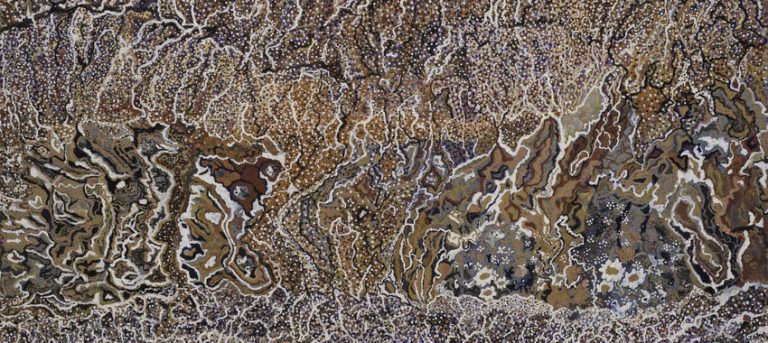We acknowledge the Traditional Owners of the land on which the Queensland Art Gallery | Gallery of Modern Art stands and recognise the creative contribution First Australians make to the art and culture of this country.

Mavis Ngallametta / Kugu-Uwanh people / Australia 1944–2019 / Ngak-pungarichan (Clearwater) 2013 / Synthetic polymer paint and natural pigments with synthetic polymer binder on canvas / Purchased 2013. Queensland Art Gallery | Gallery of Modern Art Foundation / Collection: Queensland Art Gallery | Gallery of Modern Art / © The Estate of Mavis Ngallametta
Mavis NGALLAMETTANgak-pungarichan (Clearwater) 2013
On Display: GOMA, Gallery 3.5
Ngak-pungarichan (Clearwater) depicts an important site for Ngallametta’s Kugu people to the south of Aurukun. She was able to reconnect with this remote region as a result of helicopter trips associated with mapping the effects of climate change. As Ngallametta has said:
Ngak-Pungarichan is the traditional name of a place close to the salt pan between the Kendall River and Knox Creek on the west side of Cape York. It is in the coastal country of the Kugu people. My Country, my tribal land. It means ‘clear water’.
Iiru agu ngathurum nhampa Ngak-pungarichan. Agu iiru thinthu agu pathcang thinthu Kendall River pal Knox Creek pal kuwa Cape Yorkang. Agu kuwa Kugu ngananam. Agu ngathurum, agu iiru nhampa ‘clear water’.1
As much as the painting appears to be an aerial view of the topography and vegetation of Kendall River country, it also draws the eye into intricate details of the landscape, with flower-like forms and small tributaries reflecting this richly textured landscape.
Endnotes:
1. Kugu Uwanh translation by Katherine Ngallametta and Maisie Shortjoe; facilitated by Louise Ashmore.
Mavis Ngallametta was born in 1944 into the Marbunt family of the Kugu people on their traditional country, near the Kendall River in west Cape York Peninsula. An elder of the Putch clan and a cultural leader of the Wik and Kugu people of Aurukun, Mavis is remembered for her rich legacy to her community and to art and culture nationally. Mavis embarked on her journey to become a painter relatively late in life — she did not pick up a paintbrush until 2008, at the age of 64.
Mavis lived a traditional life in the bush until she was around five, when her family was moved to the Presbyterian Mission at Aurukun. She maintained connections with family members and elders despite this upheaval, and, in time, learnt to weave dilly bags and fruit bowls made from cabbage palm and pandanus. As a result, she was first recognised for her weaving using traditional materials, which later expanded to include recycled driftnets and marine debris.
In 2008, Ngallametta began making small paintings depicting important cultural sites, and from 2010, her works grew in scale. Mavis tended to depict sites of personal significance in her paintings. Recurring subjects include Ikalath, where she collected white clay; her traditional country of Kendall River; Wutan, a camping site belonging to her adopted son Edgar; and various pamp, or swamps, dotted around Aurukun.
Discussion Questions
1. Look closely at the detail of the painting. What elements has the artist used to show the richness of her special place?
2. Look at the overall artwork, then look at the intricate details within it. What did you see at first glance? What did you notice close up? How do these two different perspectives contribute to the panoramic view?
Classroom Activities
1. Look again at Mavis Ngallametta’s painting, and think about how you could use texture and line to show details of a special place to you. Make an artwork using thick and textured paint and different brushes.
2. Select an aerial view photograph of a landscape. Focus on a section of the landscape to develop a panoramic painting. Use layers to build surface textures, lines, shapes and images. Consider adding visual clues to communicate your perspective on climate change.